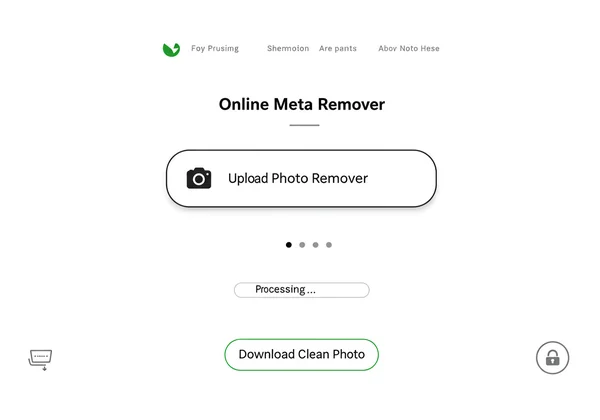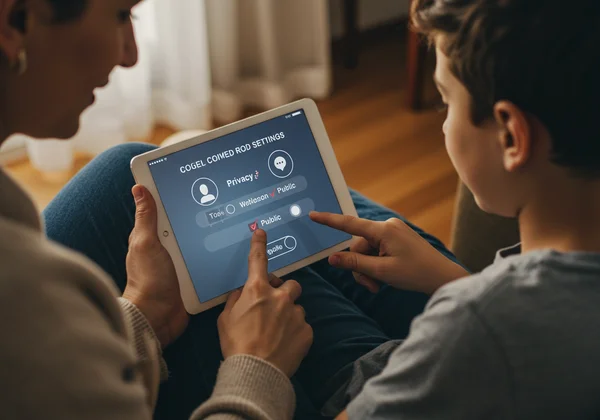家长指南:儿童照片安全分享与 EXIF 数据移除
作为家长,我的手机里塞满了成千上万张孩子们的照片——第一次迈步、傻傻的笑容、生日派对。在网上与家人朋友分享这些珍贵瞬间,感觉是现代生活自然而然的一部分。但不久前,一位朋友问了我一个问题,让我猛然警醒: 如果这些看似无辜的照片携带了可能危及孩子隐私和安全的隐藏信息怎么办? 这让我一头扎进了照片元数据的研究,并发现我们的照片往往会泄露的信息远超我们的预期。本指南旨在帮助每一位像我一样,希望在确保孩子安全的前提下分享育儿乐趣的家长。这是关于采取一个简单、主动的措施来保护我们的小朋友在数字世界的安全,而且使用一个好的 元数据移除工具 比你想象的要容易。

为什么 安全照片分享 对您孩子的隐私至关重要
我们会在社交媒体上发布照片,在群聊中发送,并通过电子邮件发给祖父母。从我们的角度来看,我们只是在分享一个瞬间。但在当今高度互联的世界中,每一条数字信息都可能被收集和分析。对于家长来说,“安全照片分享”不仅仅关乎谁能看到照片;它更关乎照片携带的那些隐藏信息。
日常照片分享的 意想不到的风险
每次您用智能手机或数码相机拍照时,都会生成一个隐藏文件。这个文件被称为 EXIF 数据,它包含了一系列详细信息:照片拍摄的确切时间、日期、使用的相机或手机类型,以及通常是照片拍摄地点的精确 GPS 坐标。分享一张生日派对的照片可能会泄露您的家庭住址。一张公园里的照片可能会精确指出您家人最喜欢的活动地点。随着时间的推移,一系列照片可以描绘出您孩子生活的详细地图——他们的学校、他们的游乐场、他们的日常作息。这并非是杞人忧天;而是要意识到我们无意中留下的数字痕迹。

在 数字世界 中保护他们的身份
孩子的数字足迹早在他们创建第一个社交媒体账户之前就已经形成了。我们分享的照片构成了他们生活的一个永久的、可搜索的记录。通过移除可识别的元数据,我们迈出了保护他们隐私的关键一步。这确保了一张可爱的照片仅仅是一张照片,没有任何可能被利用或用于建立孩子个人档案的附加数据。在他们足够大能够自行管理之前,保护他们的身份是我们的责任。使用一个 简单的在线工具 可以让这个过程变得无缝。
理解 EXIF 数据:您孩子照片中隐藏了哪些信息
那么,这些隐藏的数据到底是什么?EXIF(可交换图像文件格式)数据相当于在冲印照片背面写下的备注。它由您的相机或手机自动生成,并直接嵌入到图像文件中。虽然其中一些是无害的技术信息,但其他部分可能包含高度敏感的个人信息。
不仅仅是位置: 设备、时间等
虽然 GPS 位置是最令人担忧的元数据,但它并非唯一的问题。EXIF 数据还包括:
- 设备信息:您的手机或相机的品牌和型号(例如,iPhone 14 Pro,佳能 EOS R5)。这可以透露您的经济状况或技术偏好。
- 日期和时间:照片拍摄的确切日期和时间,精确到秒。这可以用来建立模式和日常习惯。
- 曝光设置:诸如 ISO、光圈和快门速度等详细信息。虽然主要与摄影师相关,但它仍然会丰富数字档案。
- 使用的软件:有时,它甚至会记录用于编辑照片的软件。
所有这些细节,当拼凑在一起时,可以描绘出您家庭生活令人惊讶的详细画面。
现实场景:元数据如何被滥用
让我们具体化一点。想象一下,您发布了一张孩子开学第一天的照片,并加上了 #开学第一天 的标签。别有用心的人可以下载这张照片,提取 GPS 数据,从而知道您孩子学校的确切位置。如果您持续发布自家后院的照片,他们就能精确找出您的家庭住址。
另一种情况:您分享了一张家庭度假的照片。元数据显示您身在千里之外,并且您离家的确切日期,无意中透露了您的家是空着的。这些并非遥不可及的电影情节;在数据唾手可得的世界里,它们是真实存在的风险。这就是为什么在照片公之于众之前 清理您的图像 如此重要的原因。
如何轻松 移除儿童照片中的位置信息 (及其他敏感数据)
好消息是,保护您的孩子其实非常简单。您不需要成为技术专家,也不需要购买昂贵的软件。解决方案是使用一个 EXIF 移除工具,在分享照片之前从中剥离数据。当我找到一个能一键完成此过程的工具时,我感到非常欣慰。
使用我们的 简单元数据移除方案 逐步操作
在尝试了几种方案后,我选择了 MetadataRemover.org,因为它注重隐私和简洁性——这正是忙碌的家长所需要的。操作起来非常简单:
- 访问网站:打开您的网络浏览器并进入主页。
- 上传您的照片:您可以直接将要分享的照片拖到页面上,或者点击从您的电脑或手机中选择文件。
- 自动移除: 元数据移除工具 会立即处理图像,移除所有隐藏的元数据。您无需勾选任何复选框或配置任何设置。
- 下载清理后的照片:“下载”按钮会立即出现。点击它,您就会得到一个干净、无元数据的照片版本,可以安全地分享了。
整个过程只需不到 10 秒。它已成为我照片分享流程中不可或缺的一步。

快速免费:我们为忙碌父母提供的在线工具
之所以成为我的首选解决方案,是因为它致力于用户隐私和便利性。它是完全免费的,您无需创建账户或注册。最重要的是,该网站有严格的隐私政策:他们不存储您的图像。照片经过处理后,干净的版本会返回给您;原始照片绝不会保存在他们的服务器上。对于关注隐私的家长来说,这是最重要的功能。
在发布前验证您的照片是否“ 干净 ”
您怎么知道它起作用了呢?下载“干净”的图像后,您可以在电脑上检查其属性(右键点击并选择“属性”或“获取信息”)。您会发现,曾经显示相机型号和 GPS 数据的详细信息选项卡现在是空的。这个小小的检查能让您完全安心,知道现在可以毫无顾虑地发布那张可爱的照片了。
超越元数据移除的 儿童在线安全 实用技巧
移除元数据是强大的第一步,但全面的儿童在线安全还涉及一些其他好习惯。可以将其视为数字育儿——就像我们教孩子过马路时要看两边一样,我们也需要设置数字护栏。
检查社交媒体平台的 隐私设置
花 15 分钟检查您在 Instagram、Facebook 和 Twitter 等社交媒体账户上的隐私设置。确保您的个人资料设置为“私密”,这样只有经过批准的朋友和家人才能看到您发布的内容。这建立了第一道防线,确保您的照片从一开始就不会被公众访问。

教育年龄较大的孩子关于 数字足迹
随着孩子长大并开始使用自己的设备,就数字足迹进行开放式对话非常重要。向他们解释,他们在网上发布的任何内容都可能永远存在。教他们在分享个人信息之前进行批判性思考,无论是照片、评论还是消息。用知识武装他们是为他们负责任的数字生活做好准备的最佳方法。
赋能家长:掌控您孩子的数字足迹
在数字时代为人父母面临着独特的挑战,但也伴随着强大的应对工具。学习照片元数据乍看起来可能令人望而生畏,但掌控它是一种赋权行为。这是您现在可以采取的简单、具体的步骤,以保护您孩子的隐私和安全。通过将快速访问 元数据移除工具 纳入您的日常习惯,您可以继续自信、安心地分享您家庭的美好瞬间。
关于儿童照片隐私的常见问题
如何快速从孩子的照片中移除元数据?
最快的方法是使用专用的在线 元数据移除工具。像 MetadataRemover.org 这样的网站就是为速度和简便性而设计的。您只需上传照片,它会在几秒钟内自动清理,让您立即下载安全版本。
儿童照片中通常存储哪些敏感数据?
最敏感的数据包括照片拍摄的精确 GPS 位置、确切日期和时间,以及使用的具体设备。这些信息可能会无意中泄露您的家庭住址、孩子的学校或您家人的日常作息。
为什么家长在分享照片前移除元数据尤为重要?
儿童是弱势群体,他们的安全至关重要。元数据可以为有恶意意图的人提供孩子生活的路线图。移除这些数据是一种预防性安全措施,它堵塞了一个常见的数字漏洞,并在孩子能够自行管理隐私之前保护他们的隐私。
使用像 MetadataRemover.org 这样的在线工具来保护我孩子的照片安全吗?
是的,前提是您选择一个值得信赖的工具。 MetadataRemover.org 的一个关键安全特性是其隐私政策——它不存储、保存或记录任何用户上传的图像。处理过程是即时的,您的照片仍归您所有,确保您的数据得到安全处理。
照片中的位置数据对儿童安全构成哪些具体风险?
位置数据可以揭示高度敏感的地点,例如孩子的家、学校或经常光顾的公园。这些信息可能被用于跟踪、定位或其他恶意活动。移除位置数据可确保您分享的是回忆,而不是地图。